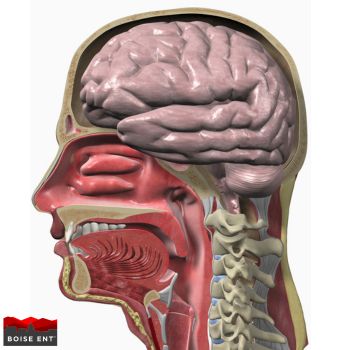What Is Swimmer’s Ear? Swimmer's ear is an infection of the outer ear canal caused…

Are Your Ears Connected to Your Throat?
If you are like most people today, the last thought you really had about the connections between your ears, nose, and throat happened during your high school biology final exam.
However, it may be time to resurrect what you remember on the topic. According to the American Rhinologic Society (ARS), an estimated 30 million adults nationwide contract sinusitis annually.
This statistic makes sinusitis one of the most common ailments in the United States today. Fully 15 percent of the population suffers from chronic (recurring) sinusitis.
So are your ears connected to your throat, and does this lead to possible infection issues? In this post, learn more about the connections between your ears, nose, and throat and what these systems can tell you about your overall health.
 The Functions of the Ears, Nose, and Throat
The Functions of the Ears, Nose, and Throat
It might seem like an overly simple question; what do the ears, nose, and throat do? The obvious answer is hearing, smelling, and swallowing and breathing, but according to Merck, the ears, nose, and throat all have individual yet related functions.
For example, both the ears and the nose are sense organs. Together, they regulate our ability to smell, hear and maintain our balance.
The throat, of course, is designed for passage of vital elements such as oxygen, fluids and food. It can also convey other things, such as phlegm, mucus and draining toxins coming from the ears or nose.
The Connection Between the Ears, Nose and Throat
The intricate network of canals and passages that connect the ear, nose, and throat can unfortunately facilitate the seamless transmission of viruses and bacteria between all three.
So how are the ears, nose, and throat connected? The ear consists of three distinct parts: the outer ear, the middle ear, and the inner ear. It is the middle ear, which links to the upper part at the back of the throat via a passage called the Eustachian tube. Similar to the lining of the nose and throat, this tube is covered in mucous. It also houses the delicate bones that transmit sound waves to the inner ear.
Moving on to the nose, it can be divided into two sections: the visible portion known as the anterior, and the inner section referred to as the posterior. The posterior part of the nose directly connects to the throat.
As for the throat, it comprises three distinct regions. The nasopharynx is located at the rear of the nose, followed by the oropharynx positioned behind the mouth. Finally, the laryngopharynx serves as the location of the voice box.
Enveloping this entire system are hollow cavities within the skull, collectively known as the sinuses. These sinuses, approximately an inch in size, are situated in the cheekbones, the center of the forehead, between the eyes, and within the nose.
The interconnected nature of the ear, nose, and throat (ENT) system is vital for respiration, olfaction (sense of smell), balance, and gustation (sense of taste). The connected membraneous sinus cavities also assist with air conduction and filtration, resonance chambers for hearing, and fighting off infection.
But because all three are lined with similar membranes and are connected, according to Everyday Health, they share some common health hazards.
In other words, since a major role of those membranes is fighting off germs, when the nose gets infected, the ears and throat often get infected too, and vice versa.
Clearing Up Infection in All Three Systems
Once you come down with sinusitis, the post-nasal drip can quickly cause irritation in the equally sensitive membranes of your throat. The sinuses, meanwhile, often swell as they fill with mucus, causing pressure headaches (“sinus headaches”) and ear blockage that often makes even nearby sounds appear to be coming from far away.
This interconnectedness requires a proactive approach. The more you can do to reduce sinus passage swelling and post-nasal drip, the less chance of the infection spreading between ears, nose and throat.
Ears, nose and throat infections can be frustrating and disruptive, often requiring expert care for proper treatment. If you’ve been searching for an “ENT Boise”, “ENT Eagle, Idado“, or”ears nose and throat doctor near me“, look no further than Boise ENT for our comprehensive care. With their skilled team of specialists, Boise ENT is the trusted choice for addressing ear, nose, and throat issues effectively and compassionately.
Dr Don J. Beasley, MD is a board-certified otolaryngologist who has been practicing ear, nose, and throat medicine for over 20 years. Sinusitis surgery is one of Dr. Beasley’s ENT specialties. If you’re interested in getting your sinusitis treated today, feel free to schedule an appointment online or call our office today at (208) 229-2368
Sources:
- http://care.american-rhinologic.org/sinusitis_q_a?print
- http://www.merckmanuals.com/home/ear,-nose,-and-throat-disorders/biology-of-the-ears,-nose,-and-throat/introduction-to-biology-of-the-ears,-nose,-and-throat
- http://www.everydayhealth.com/ears-nose-throat-pictures/common-ears-nose-throat-complaints.aspx
